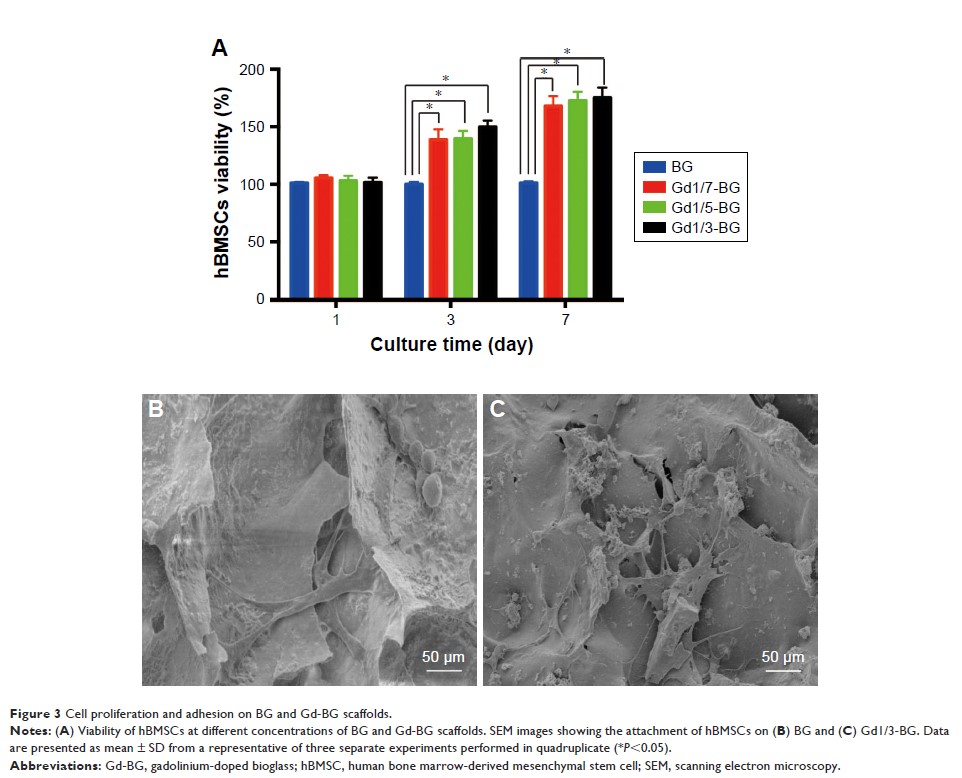108605
论文已发表
注册即可获取德孚的最新动态
IF 收录期刊
- 3.4 Breast Cancer (Dove Med Press)
- 3.2 Clin Epidemiol
- 2.6 Cancer Manag Res
- 2.9 Infect Drug Resist
- 3.7 Clin Interv Aging
- 5.1 Drug Des Dev Ther
- 3.1 Int J Chronic Obstr
- 6.6 Int J Nanomed
- 2.6 Int J Women's Health
- 2.9 Neuropsych Dis Treat
- 2.8 OncoTargets Ther
- 2.0 Patient Prefer Adher
- 2.2 Ther Clin Risk Manag
- 2.5 J Pain Res
- 3.0 Diabet Metab Synd Ob
- 3.2 Psychol Res Behav Ma
- 3.4 Nat Sci Sleep
- 1.8 Pharmgenomics Pers Med
- 2.0 Risk Manag Healthc Policy
- 4.1 J Inflamm Res
- 2.0 Int J Gen Med
- 3.4 J Hepatocell Carcinoma
- 3.0 J Asthma Allergy
- 2.2 Clin Cosmet Investig Dermatol
- 2.4 J Multidiscip Healthc

掺杂钆元素的生物活性玻璃支架通过 Akt/GSK3β 通路促进 hBMSC 的成骨分化并促进体内骨修复
Authors Zhu DY, Lu B, Yin JH, Ke QF, Xu H, Zhang CQ, Guo YP, Gao YS
Received 6 November 2018
Accepted for publication 12 January 2019
Published 11 February 2019 Volume 2019:14 Pages 1085—1100
DOI https://doi.org/10.2147/IJN.S193576
Checked for plagiarism Yes
Review by Single-blind
Peer reviewers approved by Dr Govarthanan Muthusamy
Peer reviewer comments 2
Editor who approved publication: Dr Linlin Sun
Background: Biomaterial-induced
osteogenesis is mainly related to hierarchically porous structures and
bioactive components. Rare earth elements are well known to promote
osteogenesis and stimulate bone repair; however, the underlying biological
effects of gadolinium (Gd) element on bone regeneration are not yet known.
Methods: In this
study, we successfully fabricated gadolinium-doped bioglass (Gd-BG) scaffolds
by combining hollow mesoporous Gd-BG microspheres with chitosan and evaluated
in vitro effects and underlying mechanisms with Cell Counting Kit-8,
scanning electron microscopy, alkaline phosphatase, Alizarin red staining, and
polymerase chain reaction. Cranial defect model of rats was constructed to
evaluate their in vivo effects.
Results: The
results indicated that Gd-BG scaffolds could promote the proliferation and
osteogenic differentiation of human bone marrow-derived mesenchymal stem cells
(hBMSCs). Mechanistically, the Akt/GSK3β signaling pathway was activated by the
Gd-BG scaffolds. The enhancing effect of Gd-BG scaffolds on the osteogenic
differentiation of hBMSCs was inhibited by the addition of LY294002, an
inhibitor of Akt. Moreover, the in vivo cranial defect model of rats
indicated that the Gd-BG scaffolds could effectively promote bone regeneration.
Conclusion: Both
in vitro and in vivo results suggested that Gd-BG scaffolds have
promising applications in bone tissue engineering.
Keywords: bone
scaffold, gadolinium, Akt/GSK3β pathway, bone regeneration
